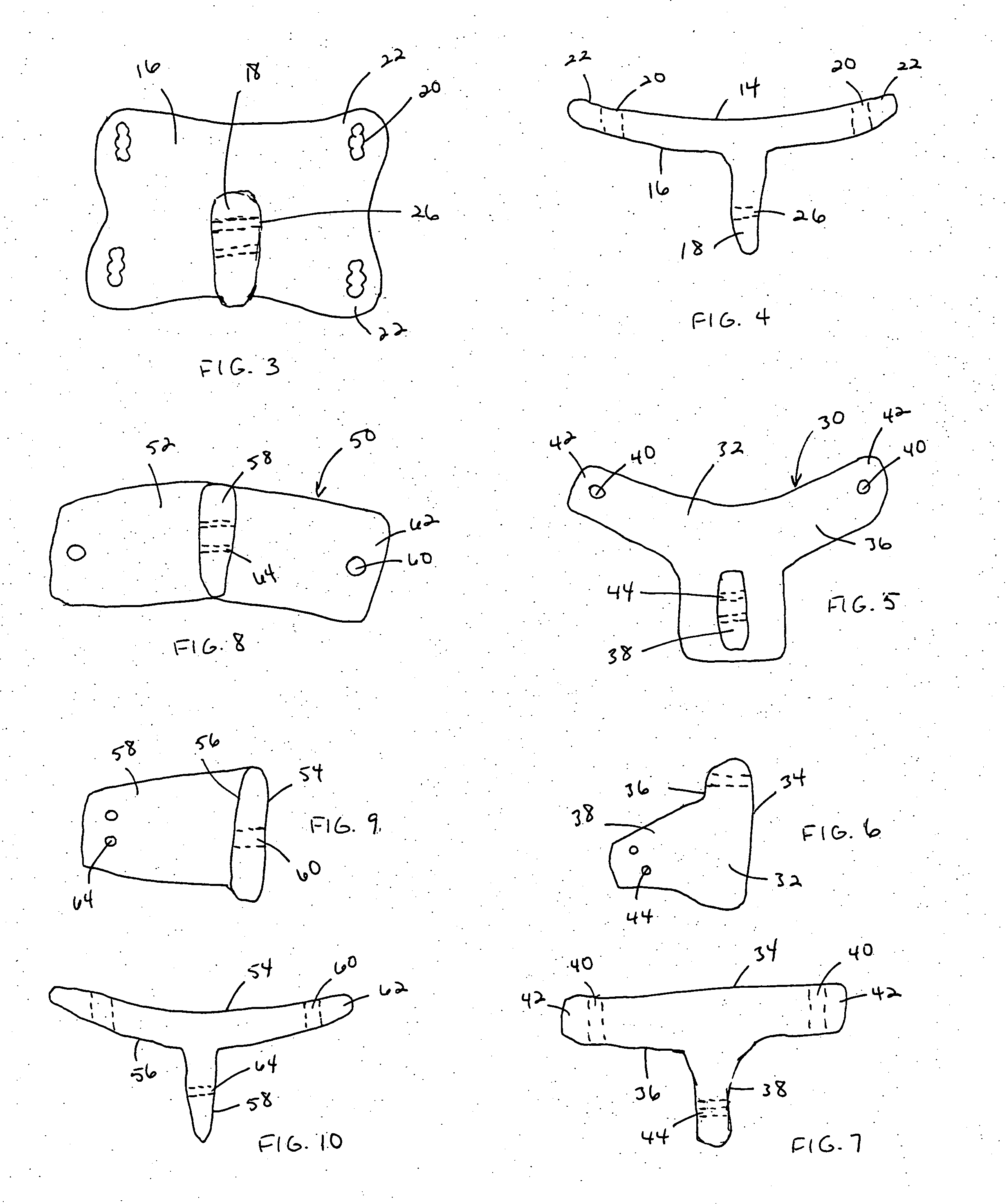Spinal implant device
a technology of spinal implants and implants, which is applied in the field of spinal surgery, can solve the problems of laminectomy instability and patients often experiencing difficulty, and achieve the effect of effectively stabilizing one or more spinal vertebrae and being manufactured at low cos
- Summary
- Abstract
- Description
- Claims
- Application Information
AI Technical Summary
Benefits of technology
Problems solved by technology
Method used
Image
Examples
first embodiment
[0034] As representatively illustrated in FIGS. 1-4, the present invention is directed to a spinal implant device, generally designated by the reference numeral 10, with a body 12 having a generally planar anterior surface 14 and a corresponding posterior surface 16 from which a projection 18 extends outwardly, the projection being substantially perpendicular to the posterior surface. The planar body 12 has a generally rectangular shape when viewed from the anterior or posterior sides, and typically includes a plurality of through-passing apertures 20 located in distal or corner portions 22 thereof for receiving fastening members 24. The apertures may provide for variable positioning of the fastening members as shown in FIG. 3, or may be generally circular for a single position. The posterior projection 18 is provided with a plurality of suture holes 26 for anchoring muscles and ligaments to the posterior projection 18.
[0035] As shown, the embodiment set forth in FIGS. 1-4 has four...
second embodiment
[0036] the spinal implant device according to the present invention, generally designated by the reference numeral 30, is illustrated in FIGS. 5-7. As with the previous embodiments, the device 30 includes a body 32 having a generally planar or gently curved anterior surface 34 and a corresponding posterior surface 36 from which a projection 38 extends outwardly. When viewed from the anterior or posterior sides, the body 32 has a somewhat triangular shape and typically includes at least two through-passing apertures 40 located in distal portions 42 thereof for receiving fastening members (not shown). The posterior projection 38 is provided with a plurality of suture holes 44 for anchoring muscles and ligaments to the posterior projection 38.
[0037] The first and second embodiments are designed for lumbar and thoracic vertebrae, with the four-aperture embodiment of FIGS. 1-4 being used to fuse two vertebrae and the dual-aperture embodiment of FIGS. 5-7 serving to stabilize a single ver...
third embodiment
[0038] the spinal implant device according to the present invention, generally designated by the reference numeral 50, is illustrated in FIGS. 8-10 and is particularly suited for use with cervical vertebrae. As with the previous embodiments, the device 50 includes a body 52 having a generally planar anterior surface 54 and a corresponding posterior surface 56 from which a projection 58 extends outwardly, generally perpendicular to the posterior surface 56. When viewed from the anterior or posterior surfaces, the body 52 has a generally rectangular shape and typically includes a plurality of apertures 60 located in distal portions 62 thereof for receiving fastening members (not shown). The posterior projection 58 is provided with a plurality of suture holes 64 for anchoring muscles and ligaments to the posterior projection 58.
[0039] In each of the three embodiments, the posterior projection has a shape intended to replicate the spinous process of corresponding vertebrae from which th...
PUM
 Login to View More
Login to View More Abstract
Description
Claims
Application Information
 Login to View More
Login to View More - R&D
- Intellectual Property
- Life Sciences
- Materials
- Tech Scout
- Unparalleled Data Quality
- Higher Quality Content
- 60% Fewer Hallucinations
Browse by: Latest US Patents, China's latest patents, Technical Efficacy Thesaurus, Application Domain, Technology Topic, Popular Technical Reports.
© 2025 PatSnap. All rights reserved.Legal|Privacy policy|Modern Slavery Act Transparency Statement|Sitemap|About US| Contact US: help@patsnap.com



